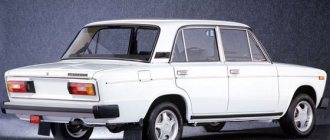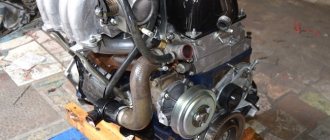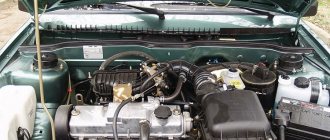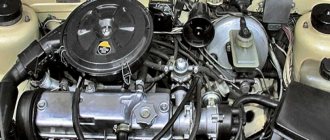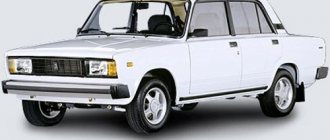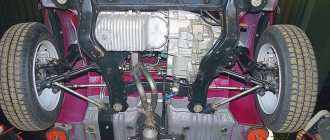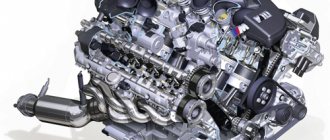In 1976, the VAZ plant began mass production of the new “sixth” model of the car with rear-wheel drive. This car was in many ways similar to the “third” model, but was positioned as more prestigious and dynamic. This was achieved by using the 2106 engine, which had a cylinder capacity increased to almost 1.6 liters and higher power and torque values.
Thanks to its high power, the engine turned out to be suitable for use in the off-road Niva model 2121. Partly due to this, this engine turned out to be the longest-lived power unit of the “classic” family. Today, production continues of several modifications of engines created using the “six” engine block.
Main differences
The design of the new engine was based on solutions tested on already produced VAZ power units. The main difference was the block, in which the cylinder diameter was increased by 3 mm. At the same time, the height of the counterweights on the crankshaft remained similar to the one and a half liter engine of the “third” model.
Due to the increase in volume, the power characteristics of the 2106 engine increased slightly to 80 horsepower. Mated to the engine was a four-speed gearbox with specially selected gears. Thanks to it, the car could reach a speed of 152 km/h, which was a very good indicator at that time.
The applied method of increasing volume has been used by designers before. This is exactly how the “eleventh” 1.3-liter engine was created based on a slightly bored block of the very first Tolyatti 1.2-liter unit.
In what models was the VAZ used?
Improved engine characteristics made it possible to equip VAZ cars of the following models with it:
Due to the following difficulties in manufacturing some parts, management considered the 2106 motor to be economically unprofitable and it was discontinued.
Engine block
The main part of the engine is the cylinder block, cast from cast iron along with the lower part of the crankcase. This part contains seats for five supports of the main engine shaft. The lower support covers are processed together with the crankcase and are not interchangeable with each other. The design of all bearings uses replaceable liners with thin walls made of a special alloy. The ends of the shaft are sealed with special sealing glands. The use of such parts prevents oil leakage when the engine is running.
A coolant pump is installed on the front of the engine. The pump is driven by a conventional V-belt from the crankshaft pulley. The same belt rotates the generator, located on the side of the 2106 engine crankcase. The generator is mounted on a special bracket and can be rotated relative to one of the supports. Thanks to this, the tension of the drive belt is adjusted. On the back of the block there is a clutch housing, on which there is a seat for the starter.
How to connect wires correctly
When replacing high-voltage conductors, they are first connected to the ignition distributor. The distributor cover is convenient in that it is always installed in one position. There is a special mark on it, thanks to which it will not be difficult to place the part in place. Before connecting the wires, inspect the cover. It must be intact, since if cracks appear, the performance of this unit is not guaranteed.
The mark on the distributor cover is located next to the wire socket of the first cylinder. The firing order of the cylinders is slightly out of order (1-3-4-2) due to the ignition slider. It moves around the circle (distributor) counterclockwise. It is precisely by this principle of movement of the slider that it is easy to remember the order of the wires. They need to be connected to carburetor and injection VAZ-2109 according to the same principle. On the distributor cover, connect the wires according to the principle of movement of the slider, this is the only way you can set the ignition correctly:
- the socket of the first cylinder is located at the mark;
- the third one is connected at the very bottom;
- on the same line with the socket of the first, there is a place for the wire to the 4th cylinder;
- at the top point the second cylinder is connected.
On the engine itself, the cylinder numbering goes from the location of the timing belt to the starter, that is, from left to right. The fourth cylinder is closest to the starter, and the first is closest to the timing belt. When connecting, it is important to look at which socket of the distributor cover the wire comes from, if you confuse their location, the car will not start.
If you have connected the wires correctly, but the car still does not start, then the problem may be in them. Check high-voltage conductors for integrity. If you haven't changed them in a while, it's worth buying a new set. The peculiarity of these wires is that over time microcracks can form on their surface. They lead to a lack of spark when the ignition distribution system is working. Moisture and dust get into these cracks, which damages the wire from the inside, although it appears intact from the outside.
Car enthusiasts recommend purchasing sets of high-voltage wires from foreign manufacturers, as they last much longer than stock or domestic ones. It is advisable to replace the spark plugs along with the wires, especially if cracks or carbon deposits appear on their surface. This is necessary so that after repair you definitely do not have problems with ignition
Gas distribution mechanism
The front of the engine is covered with an aluminum cover, behind which is the valve shaft drive chain. The oil pump with a gear circuit rotates from the same circuit. The pump is responsible for supplying oil under pressure to the bearings. Oil is drawn from a reservoir located in a removable engine sump. To clean the oil, a filter with a replaceable paper element is used.
The valve drive shaft is located directly in the head. This design made it possible to ensure good technical characteristics of the VAZ-2106 engine for its time. A photo of the motor is shown below.
The design of the exhaust gas exhaust valves uses a combined design of two parts welded together. Both parts are made of different grades of steel. This scheme made it possible to ensure higher durability of the part. The less thermally stressed intake valve is made from a single material. The surfaces of all valves undergo cycles of thermal and chemical treatment, which allows them to operate in high temperature conditions.
Maintenance recommendations 2106
Servicing a VAZ 2106 is not much different from servicing a 03 or 011 model. Much has already been said and written about this. The main difference between the service of the “Six” and its donors is the increased requirements for the quality of engine oil. This motor is more powerful and stronger, so it needs to be lubricated better. Experienced drivers, whose 2106 engine has gone through about 200 thousand kilometers without major repairs, advise pouring only semi-synthetic 10W40 and 5W40 into the engine. The oil change period should in no case exceed 10,000 kilometers. It’s better to shorten this period a little.
The legendary 1.6 liter engine of the VAZ 2106 has currently lost ground to more dynamic and powerful engines. However, there is no modern engine that has enjoyed the same popularity for the same number of years as the 06 model Zhiguli.
Power and ignition system
To supply fuel on early versions of the 2106 engine, a Weber system carburetor was used. With the start of production of more modern devices such as “Ozone”, they began to be installed on the “sixth” engine. With the new carburetor, the engine became a little more economical, but also lost several horsepower. In the early 2000s, engines began to be equipped with a fuel injection system. Vehicles of the “fifth” and “seventh” models were equipped with such power units.
On carburetor cars, ignition was used with pulse distribution from a mechanical device mounted on the side of the crankcase. The injection version is equipped with an electronic module that distributes ignition pulses according to signals from the engine shaft position sensor.
Maintenance Procedure
The classic design of the internal combustion engine allows you to get by with simple steps when servicing the engine:
| Maintenance object | Time or mileage (whichever comes first) |
| Timing belt | replacement after 100,000 km |
| Battery | 1 year/20000 |
| Valve clearance | 2 years/20000 |
| Crankcase ventilation | 2 years/20000 |
| Belts that drive attachments | 2 years/20000 |
| Fuel line and tank cap | 2 years/40000 |
| Engine oil | 1 year/10000 |
| Oil filter | 1 year/10000 |
| Air filter | 1 – 2 years/40000 |
| Fuel filter | 4 years/40000 |
| Heating/Cooling Fittings and Hoses | 2 years/40000 |
| Coolant | 2 years/40000 |
| Oxygen sensor | 100000 |
| Spark plug | 1 – 2 years/20000 |
| Exhaust manifold | 1 year |
As the actual life of the internal combustion engine increases, consumables may be replaced more frequently than specified, or operations for cleaning the carburetor, engine, jets, and other attachments may be added.
Basic modification
Due to its wide distribution and low price, the “six” engine often becomes the target of tuning. The 2106 engine is equipped with a new camshaft with changed timing and valve opening height. In this case, valves with an increased diameter are installed, which improves the filling of the cylinders.
The channels themselves for supplying and discharging working gases inside are carefully polished, since irregularities on the walls create turbulence in the flow of moving gases and worsen operating parameters. These two methods are the most basic ways to increase the power of a 2106 engine.
The most common breakdowns of the sixth engine
Car owners most often encounter the following defects in engine operation:
- The internal diameter of the cylinder increases by 0.15 mm after traveling more than 5 thousand km. This defect occurs if the engine lubricant is not replaced in a timely manner.
- The camshaft is worn out.
- Sound effects in the form of tapping in the engine. This defect can be eliminated by adjusting the valves and replacing the fuel with higher octane fuel. If these measures do not help, then you need to contact the nearest service station, where the pistons and connecting rod bearings will be diagnosed and repaired.
- Oil pressure drops. In this case, the lubricant does not reach the rubbing surfaces, as a result of which the friction force increases, causing the gaskets to burn out, accelerated wear of the working parts, and the device becomes unusable.
- Creaks indicate a breakdown in the timing chain tensioner, damper or pump bearing.
- If the engine stalls while driving, you need to look into the ignition or power systems.
- The engine turns off at idle when there is a failure in the idle speed or air damper adjustments.
- Engine trouble, with this defect it is necessary to adjust or replace burnt valves and cylinder head gasket. The cause of tripling can also be fuel with a low octane number.
